C. elegans and mutants with chronic nicotine exposure as a novel model of cancer phenotype
- PMID: 26574927
- PMCID: PMC6093410
- DOI: 10.1080/15384047.2015.1108495
C. elegans and mutants with chronic nicotine exposure as a novel model of cancer phenotype
Abstract
We previously investigated MET and its oncogenic mutants relevant to lung cancer in C. elegans. The inactive orthlogues of the receptor tyrosine kinase Eph and MET, namely vab-1 and RB2088 respectively, the temperature sensitive constitutively active form of KRAS, SD551 (let-60; GA89) and the inactive c-CBL equivalent mutants in sli-1 (PS2728, PS1258, and MT13032) when subjected to chronic exposure of nicotine resulted in a significant loss in egg-laying capacity and fertility. While the vab-1 mutant revealed increased circular motion in response to nicotine, the other mutant strains failed to show any effect. Overall locomotion speed increased with increasing nicotine concentration in all tested mutant strains except in the vab-1 mutants. Moreover, chronic nicotine exposure, in general, upregulated kinases and phosphatases. Taken together, these studies provide evidence in support of C. elegans as initial in vivo model to study nicotine and its effects on oncogenic mutations identified in humans.
Keywords: C. elegans; MET; MT13032; PS1258; PS2728; RB2088 and nicotine; SD551; vab-1.
Figures
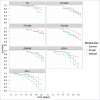
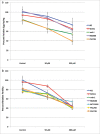
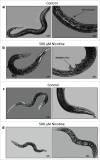
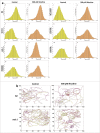
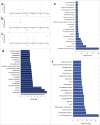
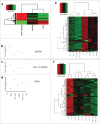
References
-
- De Biasi M, Dani JA.. Reward, addiction, withdrawal to nicotine. Annl Rev Neurosci 2011; 34:105–30; PMID:21438686; http://dx.doi.org/10.1146/annurev-neuro-061010-113734 - DOI - PMC - PubMed
-
- Le Foll B., Goldberg SR. Effects of nicotine in experimental animals and humans: an update on addictive properties. Handbook Exp Pharmacol 2009; 335–67; PMID:19184655; http://dx.doi.org/10.1007/978-3-540-69248-5_12 - DOI - PMC - PubMed
-
- Dasgupta P, Rizwani W, Pillai S, Kinkade R, Kovacs M, Rastogi S, Banerjee S, Carless M, Kim E, Coppola D, Haura E, et al. . Nicotine induces cell proliferation, invasion and epithelial-mesenchymal transition in a variety of human cancer cell lines. International journal of cancer. J Int du Cancer 2009; 124:36–45; PMID:18844224; http://dx.doi.org/10.1002/ijc.23894 - DOI - PMC - PubMed
-
- Davis R, Rizwani W, Banerjee S, Kovacs M, Haura E, Coppola D, Chellappan S. Nicotine promotes tumor growth and metastasis in mouse models of lung cancer. PloS One 2009; 4:e7524; PMID:19841737; http://dx.doi.org/10.1371/journal.pone.0007524 - DOI - PMC - PubMed
-
- West KA, Brognard J, Clark AS, Linnoila IR, Yang X, Swain SM, Harris C, Belinsky S, Dennis PA. Rapid Akt activation by nicotine and a tobacco carcinogen modulates the phenotype of normal human airway epithelial cells. J Clin Invest 2003; 111:81–90; PMID:12511591; http://dx.doi.org/10.1172/JCI200316147 - DOI - PMC - PubMed
Publication types
MeSH terms
Substances
Grants and funding
LinkOut - more resources
Full Text Sources
Other Literature Sources
Miscellaneous
